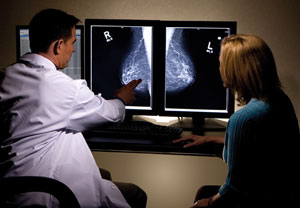Process improvements help BSV mission

BreastScreen Victoria has developed an automated data capture solution to improve its interactions with women seeking to obtain early detection of breast cancer, resulting in a major improvement to workflow.
The public health program is currently on track to provide 246,000 free breast screens to women across the state this year, a number that has continued to grow over the last decade. Women are invited into the program on a two-yearly basis from the age of 50 to 74, initially by mail with notifications then able to be shifted to electronic methods should the woman indicate their preference.
The number of women in BreastScreen Victoria’s program, in line with Australia’s ageing population, is set to increase with the proportion of the population aged 65 and over by 2040.
Repetitive and time consuming paperwork is one obstacle to efficient screening, something that BreastScreen Victoria is tackling with data capture and automatic population of forms from enterprise applications.
This process began in 2014 with the implementation of Objectif Lune PlanetPress for output management, as a way to generate client centric communications to women including invitation, confirmation and result letters. Within the confirmation letter, the women also receive a registration form which is now pre-populated with personalised customer data. This has delivered a more streamlined process for women in completing the form, and also for BreastScreen Victoria in that the woman can be processed much faster when the woman attends a screening appointment.
The software also provided the option for women to receive their reminder and appointment confirmation via HTML enriched emails utilising Objectif Lune’s PlanetPress Connect platform. By reminding women to book their screening appointment electronically, BSV has seen an increase in usage of their online bookings system from 8% to 30%. Meanwhile 40% of women are now opting to receive their appointment confirmation via email realising a significant saving in paper and postage costs.
Solution provider Pitney Bowes has now taken the solution further with an ABBYY FlexiCapture solution to capture key field data from the client registration form. The scanned image of the form along with some key data is extracted from the form, is passed to the patient management system for permanent storage.
A second FlexiCapture workflow is used to OCR and automatically classify nearly 200 different types of paper forms. BSV is currently scanning historical client paper files as part of moving to a fully electronic workflow.
In order to efficiently scan this historical data, the software has enabled 85% of forms scanned to be automatically classified without intervention from the operator. The remaining forms (or exceptions), are routed to operator(s) at remote site(s) to verify the classification of the document. Classification is a highly important part of the process as if a document is miscategorised, there is a possibility that key information is lost or valuable time may be wasted by the healthcare professional trying to find required files. This is why the automation of this process by ABBYY FlexiCapture was such an important part of the overall solution.
The forms are then stored in BSV’s patient management system (Gecko) as part of the electronic client record. Once scanned, the need to retrieve the paper client file from storage each time the woman is screened is removed, thus realising a significant cost savings to BSV.
FlexiCapture saves staff time from sifting through hundreds of paper client files trying to locate the forms(s) of interest. Having this data available electronically, it can be readily accessed realising further efficiencies in the BSV workflow.
Henry Patishman, Director of Sales at ABBYY Australia, said “Healthcare professionals at BreastScreen Victoria are being saved a lot of time doing administrative work. The solution has also brought significant scalability and knowledge sharing into the organisation. These cost savings are redirected towards BreastScreen Victoria’s key performance matrix which is screening more women as the program continues to expand. “
“This partnership has enabled BreastScreen Victoria to deliver significant change to the program in a cost effective, and timely manner,” explained BreastScreen Victoria’s Senior Project Manager, Greg Maudsley.
“Women in our program have embraced the option to be contacted electronically and now enjoy more personalised correspondence. This has realised a project outcome that exceeded expectations.”
